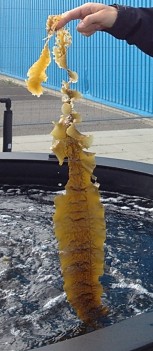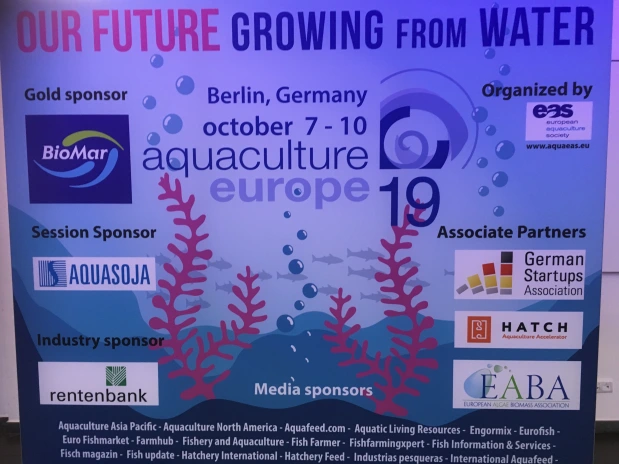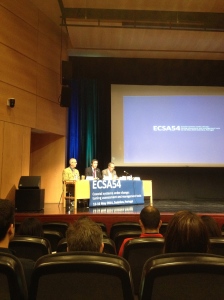It is always an uplifting experience to attend a scientific conference. Rooms full of people passionate about their work and, in my line of conferences, the life in the sea. As I am currently “out of office” from the seaweed research, doing a post doc at Gothenburg University, I find myself now in Berlin on the European Aquaculture Conference. It is interesting to see how different conferences are when there is also a strong market and business connected to the research. Here there are up to ten parallel sessions on everything from fish welfare, everything shrimp, genomics, and epigenetics to reproduction and broodstock management and macroalgae.
![IMG_5562[1]](https://balticseaweed.files.wordpress.com/2019/10/img_55621.jpg?w=660)
The first session I attend today is on aquaponics. This is the co-growth of fish, who excrete nutrients, with vegetables, who take up these nutrients. This is something we will see more of in the future, and I have been following the development of these techniques over the years. It was very interesting to hear how far the techniques have come today. There are now free download models that you can use to calculate how much algae you can grow together with fish, depending on what type of food you feed the fish. Super cool!
My favorite presentation was a small pilot study on feeding sea urchins with land grown vegetables (carrots, maize and soy) and then let sea cucumbers eat the waste and faeces. The experiment showed good growth in sea cucumbers and good gonad growth (roe sacks, the bits you eat) in sea urchins. The really good thing is that this shows that you don’t need fish meal in the diet, which has higher negative impact on the environment, and also the vegetables costs less than fish meal. From 9 euros of vegetables, they produced 25 euros worth of sea urchin roe and 40 euros of dried sea cucumber. This is the kind of presentations that gives me inspiration for my own research and also hope for the future food production.
![IMG_5570[1]](https://balticseaweed.files.wordpress.com/2019/10/img_55701.jpg?w=660)
A very interesting presentation by Luca Grosso on how to co-grow sea urchins and sea cucumbers using land-grown vegetables instead of fish meal.
Erik Malta from the Spanish aquaculture center (ctaqua) presented experiments on how to grow the green algae Ulva ohnoi (yes, actual name. Scientists can have a sense of humour) indoors in photobioreactors. Seaweed production have traditionally been limited to countries with traditional harvest, such as Ireland and France. But now other countries are also interested in producing seaweed, but how do you do this if you have little or no coastline suitable? The answer is land based. In this way you can produce large volumes of clean seaweed (no sand in your teeth there) and you can also monitor and to some extent control the nutrient quality of your produce. In this way you can optimize algae for whatever use you grow them for, be it animal feed, biofuel or human consumption. Green algae contain numerous types of oligosugars, as well as lipids (fat) which have a good market. This is underscored by the fact that most talks in this session is about farming green algae.
![IMG_5579[1]](https://balticseaweed.files.wordpress.com/2019/10/img_55791.jpg?w=660)

Saccharina latissima
Siv Etter fron NTNU in Trondheim told of her studies on ammonium uptake in juvenile sugar kelp Saccharina latissima near salmon fish farms in Norwegian fjords. The Norwegian fish farms produce a lot of waste that contaminates the water column, but could be a resource to macroalgae if some calculations and strategical thinking is applied. The study placed small sugar kelp in either nutrient enriched seawater of 7 different concentrations or “clean” seawater, so growth could be compared. The nutrients tested was nitrate, ammonium and a mix of both. The results show a remarkably quick uptake of ammonium by the kelp. In only a matter of hours, the kelp had taken up all ammonium in the test aquaria. They discovered that sugar kelp actual prefers ammonium over nitrate, and only starts taking up nitrate after the ammonium is depleted. This is an extremely interesting and important discovery that shows how integrated systems of several different species is the way to reduce negative environmental impact.
Sofiia Tretiak from Germany has studied how to optimize the antioxidant activity in sea vegetables (a lovely name for macroalgae) when they are grown in RAS (recirculating aquaculture systems). The role of antioxidants in an industrial perspective is to stop the deterioration of fatty acids in produce, as low degradation gives a much longer shelf life and thus reduces food waste. The algae in the study was placed either in normal or high salinity and either also desiccated for some time or not, so in total four different treatment. Measurements were taken for growth rate, where all but the control (normal salinity, no desiccation) decreased in growth. They also measured the photosynthetic activity, showing stress in all but control treatments as well. They then moved on to add light dosage to this. Seaweeds need a certain dose of light per day. They can either get a small dose over a longer period of time, or a high intense short period, the effect on growth will be similar if the total dose is the same. The experiment tried high and low level of light for shorter and longer periods of time. But if given a low level of light for a short time, an extra boost of UV light showed a much increased growth, whereas the same treatment without UV almost completely died. So, why did they stress the seaweed so much? Well, stress is what causes the production of antioxidants, so if you want a seaweed high in antioxidants, you need to stress it real good. There was however, no clear results here on if they actually did produce more antioxidants from these treatments or not.
The final talk before we got to stretch the legs and find some lunch discussed the European seaweed value chains in an international perspective. By now my brain was good and mellow, and this was way too much economy for me to understand fully, so I conclude by stating that it was interesting to see that the seaweed production is globally divided into three different “worlds” regarding how and why. China farms for food, very large scale but with low-paid immigrant work force that is ageing and the whole industry is low tech. This is contrary to Europe, where labour is expensive and technology readily available. But in China, humans consume lots of seaweed, which we still have not begun doing in Europe. Also, the Chinese market is very innovative, looking for new species, new products and new ways to use seaweed. We can really learn a lot from them, and maybe these two different worlds are less different than they seem, as Europe is slowly catching up.
![IMG_5584[1]](https://balticseaweed.files.wordpress.com/2019/10/img_55841.jpg?w=660)
All in all a good and interesting start to the conference. I shall now attempt to dive into the poster display and look at over 500 posters!


































 Filip Volckaert summarizes genetica
Filip Volckaert summarizes genetica “We only need to know all this to achieva good ecological status
“We only need to know all this to achieva good ecological status Horror films for seaweed lovers
Horror films for seaweed lovers Cleptoplast – one of my favourite words
Cleptoplast – one of my favourite words The magic World of Fucus radicans!
The magic World of Fucus radicans! Nice and very picturesque.
Nice and very picturesque. Really!
Really! The welcome comittee
The welcome comittee Anne Magurran shows interesting and thoughtprovoking data
Anne Magurran shows interesting and thoughtprovoking data Nice and sugary! But where is the coffee?
Nice and sugary! But where is the coffee? A comparison of models
A comparison of models Another Monday at work
Another Monday at work